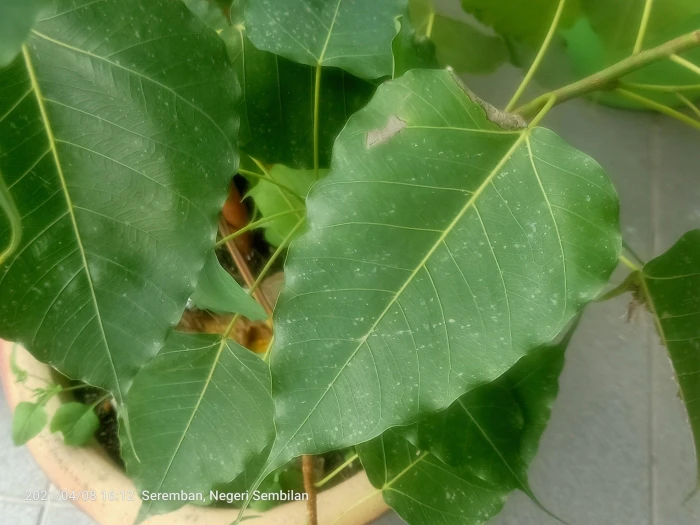Sacred Fig
(Ficus religiosa)
Sacred Fig (Ficus religiosa)
/
/

© Ong Jyh Seng
CC BY-SA 4.0
Image By:
© Ong Jyh Seng
Recorded By:
Copyright:
CC BY-SA 4.0
Copyright Notice:
Photo by: © Ong Jyh Seng | License Type: CC BY-SA 4.0 | License URL: http://creativecommons.org/licenses/by-sa/4.0/ | Uploader: ongzi | Publisher: iNaturalist |

























Estimated Native Range
Climate Requirements for Monrovia, California
| This Plant | Your Site | Plant Suitability for Your Location | ||
|---|---|---|---|---|
| • Precipitation | 1" - 336" | 18" | Your precipitation may be insufficient for this plant. Irrigate N" / year. | Irrigate N" / year |
| • High Temp. | 64°F - 115°F | 90°F | Your summer temperatures are normal for this plant. | Excellent |
| • Low Temp. | -12°F - 75°F | 42°F | Your winter temperatures are normal for this plant | Excellent |
This plant should grow well at your location with about N inches per year (Y minutes per month) of irrigation.
Summary
Ficus religiosa, commonly known as the Sacred Fig or Peepal tree, is a deciduous tree native to the Indian subcontinent and Indochina. It holds immense significance in Hinduism, Buddhism, and Jainism, often found in temple gardens and near shrines. The Sacred Fig can reach heights of up to 98 feet (30 meters) with a notable trunk diameter of up to 10 feet (3 meters). Its leaves are heart-shaped (cordate) with distinctive extended drip tips, which are thought to prevent water from collecting at the base and inviting fungal infections. The small figs produced by the tree are hidden within its leaf axils and are pollinated by the specialized wasp Blastophaga quadriceps. Flowering occurs year-round, with the figs providing a source of food for various wildlife.
The Sacred Fig is revered not only for its religious significance but also for its aesthetic appeal, with its wide canopy and attractive foliage making it a popular choice for large gardens and public spaces. It thrives in deep, alluvial sandy loam with good drainage and is tolerant of a wide range of climatic conditions, including drought. While it prefers full sunlight, it can also grow in part shade. The tree is known for its longevity and resilience, often living for hundreds of years. However, its invasive nature in regions like Hawaii and Florida is due to its fast growth and adaptability, where it can outcompete native species and disrupt local ecosystems. Gardeners should be cautious about planting it in areas where it may become invasive.CC BY-SA 4.0
The Sacred Fig is revered not only for its religious significance but also for its aesthetic appeal, with its wide canopy and attractive foliage making it a popular choice for large gardens and public spaces. It thrives in deep, alluvial sandy loam with good drainage and is tolerant of a wide range of climatic conditions, including drought. While it prefers full sunlight, it can also grow in part shade. The tree is known for its longevity and resilience, often living for hundreds of years. However, its invasive nature in regions like Hawaii and Florida is due to its fast growth and adaptability, where it can outcompete native species and disrupt local ecosystems. Gardeners should be cautious about planting it in areas where it may become invasive.CC BY-SA 4.0
Plant Description
- Plant Type: Tree
- Height: 49-98 feet
- Width: 30-50 feet
- Growth Rate: Moderate
- Flower Color: N/A
- Flowering Season: Spring, Summer
- Leaf Retention: Semi-deciduous
Growth Requirements
- Sun: Full Sun, Part Shade
- Water: Medium
- Drainage: Medium
Common Uses
Low Maintenance
Natural Habitat
Native to the Indian subcontinent and Indochina, often found in temple gardens and near shrines
Other Names
Common Names: Sacred Fig, Peepal Tree, Peepul Tree, Bo Tree, Figueira-Dos-Pagodes, Figueira-Religiosa, Ashwattha Tree, Peepul
Scientific Names: Ficus religiosa, Ficus caudata, Ficus peepul, Ficus religiosa var. cordata, Ficus religiosa var. rhynchophylla, Ficus rhynchophylla, Ficus superstitiosa, Urostigma affine, Urostigma religiosa
GBIF Accepted Name: Ficus religiosa